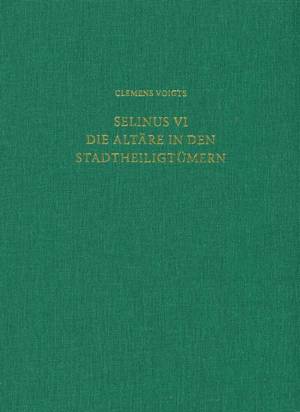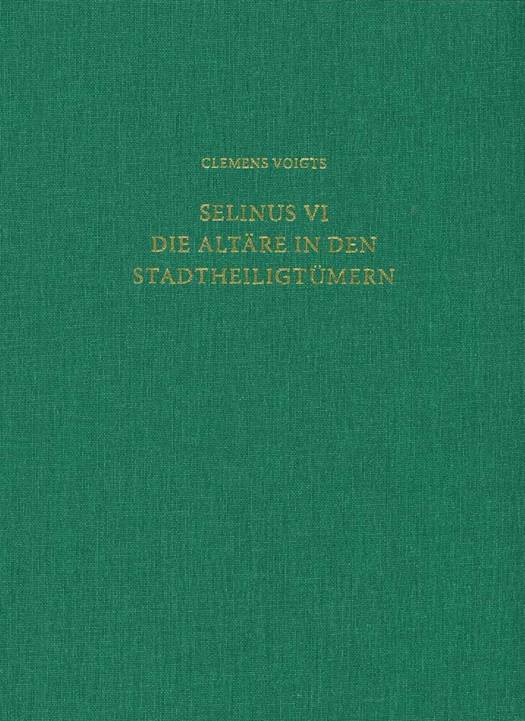
- Retrait gratuit dans votre magasin Club
- 7.000.000 titres dans notre catalogue
- Payer en toute sécurité
- Toujours un magasin près de chez vous
- Retrait gratuit dans votre magasin Club
- 7.000.0000 titres dans notre catalogue
- Payer en toute sécurité
- Toujours un magasin près de chez vous
Selinus VI. Die Altare in Den Stadtheiligtumern
Studien Zur Westgriechischen Altararchitektur Im 6. Und 5. Jahrhundert V. Chr.
Clemens Voigts
188,95 €
+ 377 points
Description
English summary: The sixth volume of the Selinus series deals with the monumental altars of Selinunte, a Greek polis situated on the south-western coast of Sicily. The book shows that in regard of altars Selinunte is an extremely significant archaeological site. Usually Greek altars are poorly preserved and therefore little known; in the urban sanctuaries of Selinunte, by contrast, the remains of nine large altars from the sixth and fifth centuries B.C. can be identified. The investigation is carried out with the methods of building archaeology: On the basis of detailed measurements and drawings the altars are analysed and graphically restored. Their dense chronological sequence allows to reconstruct the architectural development in Archaic and Classical times. It is argued that the evolution of altars starts with simple but large offering tables and leads to elaborately designed buildings, often decorated with the formal apparatus of the Doric order. In a comparative study, this line of evolution can be verified also for other Western Greek cities and sanctuaries, for example Agrigento, Syracuse, and Paestum. Special attention is paid to later modifications of altars that provide insight into the specific way in which they were used, so that questions of sacrifice and ritual practice can be discussed. With its holistic approach the book creates a comprehensive picture of the altars of the Greek West. German description: Der neue, sechste Band der Selinus-Reihe befasst sich mit den monumentalen Brandopferaltaren Selinunts. Die an der Sudwestkuste Siziliens gelegene griechische Kolonie erweist sich dabei als eine ausserst reichhaltige archaologische Statte. Wahrend griechische Altare andernorts meist schlecht erhalten und deshalb nur wenig bekannt sind, finden sich in den Stadtheiligtumern Selinunts die Reste von neun grossen Altarbauten aus dem 6. und 5. Jahrhundert v. Chr.Die Altare werden mit den Methoden der Bauforschung untersucht; anhand von Bauaufnahmen werden sie detailliert beschrieben und zeichnerisch rekonstruiert. Ihre dichte zeitliche Abfolge wird genutzt, um die architektonische Entwicklung in archaischer und klassischer Zeit nachzuvollziehen: Von schlichten, aber grossen Opfertischen hin zu aufwandig gestalteten Bauten, die mit dem Formenapparat der dorischen Ordnung geschmuckt waren. Im Rahmen einer vergleichenden Untersuchung kann das in Selinunt erarbeitete Entwicklungsmodell prinzipiell auch fur andere westgriechische Stadte und Heiligtumer bestatigt werden, so zum Beispiel fur Agrigent, Syrakus und Paestum. Ein eigenes Augenmerk gilt Umbauten an Altaren, die unabhangig von der allgemeinen architektonischen Entwicklung zu beobachten sind. Sie ermoglichen Ruckschlusse auf die genaue Nutzungsweise, d.h. auf die rituellen Handlungen, die an den Altaren vollzogen wurden. Durch den umfassenden Zugang entsteht erstmals ein anschauliches Bild von den Altaren des griechischen Westens.
Spécifications
Parties prenantes
- Auteur(s) :
- Editeur:
Contenu
- Nombre de pages :
- 194
- Langue:
- Allemand
- Collection :
- Tome:
- n° 21
Caractéristiques
- EAN:
- 9783954902132
- Date de parution :
- 13-12-17
- Format:
- Livre relié
- Format numérique:
- Genaaid
- Dimensions :
- 245 mm x 340 mm
- Poids :
- 1858 g

Les avis
Nous publions uniquement les avis qui respectent les conditions requises. Consultez nos conditions pour les avis.






